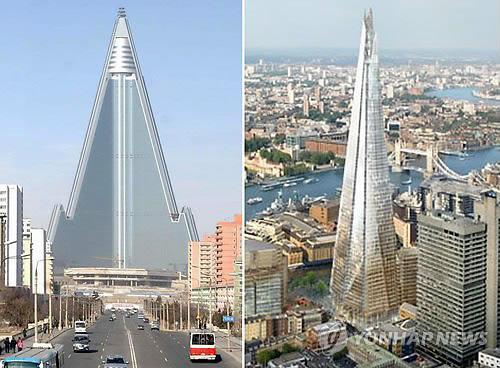The butt of countless jokes, the North Korean capital Pyongyang’s Ryukyong Hotel was the monolithic structure dominating the city’s skyline that seemed to be a veritable “white elephant.”
Work started on the 105-story, pyramid-shaped building in 1987 with hopes of being opened just two years later. But four years on, and still very much a work in progress, construction ground to a halt under the pressure of a groaning economy at a time when North Korea was about to enter the worst ravages of the famine it faced during the 1990s.
Now, with work restarted after a 15-year hiatus thanks to a $400 million investment by the Egyptian firm Orascom, London’s unfinished ― and perhaps almost equally incongruous ― building the Shard is drawing decidedly unfavorable comparisons to the Ryukyong.
“Doesn’t Renzo Piano’s London Shard look strikingly like the perpetually nearly-finished 105-story Ryukyong Hotel in Pyongyang, North Korea?” writes Marc Kushner on the online architectural community site Architizer. “Does that mean (North Korean leader) Kim Jong-il’s regime is capable of Pritzker (Architecture Prize) level work, or is Mr. Piano slipping into totalitarian mode?”
World renowned Italian architect Piano may beg to differ over such comparisons with his baby, but the passing, casual eye would perhaps not fail to see the similarities between the two structures ― that is, indeed, if they’d had the distinct pleasure of viewing the notoriously reclusive North’s prized building.
Take the space-age pyramid design; both buildings exhibit variances on the same theme, each towering over their respective capital cities like emperors presiding over compliant subjects.
Then come the platitudes. The Ryukyong and Shard are near neighbors in the list of the world’s tallest buildings, the former weighing in at 39th place and the latter trailing slightly behind at 45th.
 |
The Ryukyong Hotel under construction in Pyongyang (left), due for completion next year, is often compared to the Shard in London for their striking similarities. (Yonhap News) |
Others point out the like-minded upper-deck amenities: Five revolving restaurants are reportedly planned for the Ryukyong, while at the Shard there is set to be a viewing gallery and observation post.
Some Londoners would seem to agree with the comparisons. One blogger said the mixed-use, 87-level structure in the British capital that incorporates luxury residences, offices, restaurants and bars looked “Stalinist.”
The Beijing-based North Korea travel specialists Koryo Tours also got in on the act. In what appears to be an attempt to entice prospective tourists to visit North Korea, it compared everything from the two buildings’ respective heights and latest completion dates to the notion that they both appear to be “exaggerated” pyramid designs as well as the amenities set to be on offer in each.
Perhaps most naughtily, though, was the travel agency’s comparison of the means by which the respective construction projects got the go ahead.
“Permission to build the Ryukyong hotel was granted by North Korean leader Kim Il-sung,” Koryo Tours said in an emailed newsletter referring to the father of the country’s current leader and founder of North Korea. “Development plans for the Shard were opposed by local authorities and heritage bodies but in 2003 British Deputy Prime Minister John Prescott announced that construction had been approved.”
Both are slated to be “complete” next year ― the Shard in time for the 2012 London Olympics. With current North Korean leader Kim Jong-il jockeying to deliver on his promise that his country will be a “prosperous” nation in time for his father and “Eternal President” Kim Il-sung’s 100th birthday celebrations, some observers say the Ryukyong, too, will be ready ― on the outside at least.
For North Korea, though, the fact that the finished product, so to speak, apparently looks like applying only to the exterior is no laughing matter.
The idea, expert North Korea watchers say, appears to be to give an impression of completion, a propaganda effort tied to the 2012 promise. On that basis, the Ryukyong would provide a gleaming frontage for its citizens and beyond by April 15 of next year.
“The gossip in Pyongyang is that they will open the first two floors and the revolving restaurants,” says Nicholas Bonner, founder of Koryo Tours and the producer of several North Korean-themed films.
However, a request for comment from investors Orascom on how the construction work is progressing failed to yield a response.
But Brian Myers, a North Korean propaganda expert based in Busan and a recent visitor to the North Korean capital, believes ordinary North Koreans won’t be fooled by aesthetics masking the reality of their lives. As well as the Ryukyong, renovation work on other Pyongyang landmarks, such as the giant Kim Il-sung statue, are said to be ongoing ahead of 2012.
“I don’t consider this renovation likely to boost spirits all that much,” says the author of the critically acclaimed book on North Korea, “The Cleanest Race.”
“The strong and prosperous country campaign started in 1998 as a promise of an improved supply of food and consumer goods. Propaganda seems to be backpedalling on this promise now, judging from posters envisioning ever less spectacular spreads on family dinner tables,” he said.
“Whether the masses end up feeling cheated in 2012 is not clear, but the state of the Ryukyong Hotel is unlikely to loom very large in their thinking either way.”
Yet, it continues to loom on the Pyongyang horizon. Only time will tell whether it is the “white elephant” it has seemed to encapsulate or a harbinger of more prosperous times to come.
(Yonhap News)








